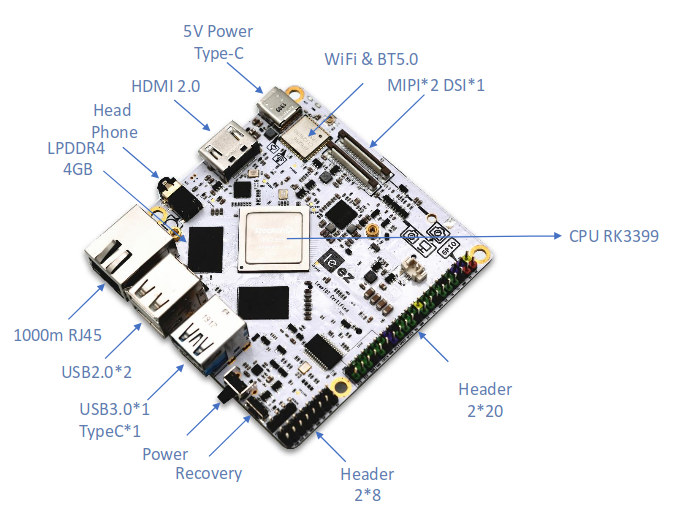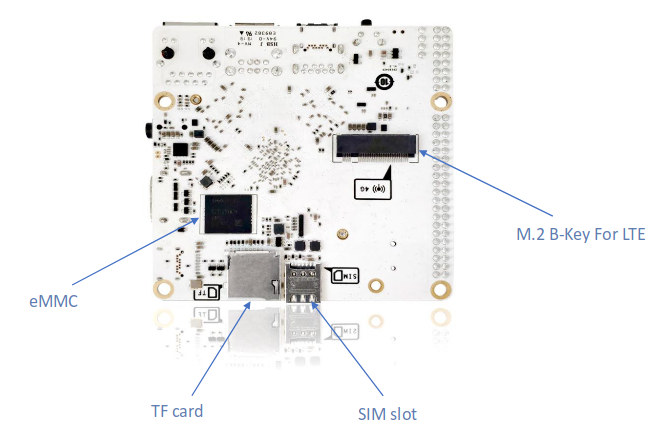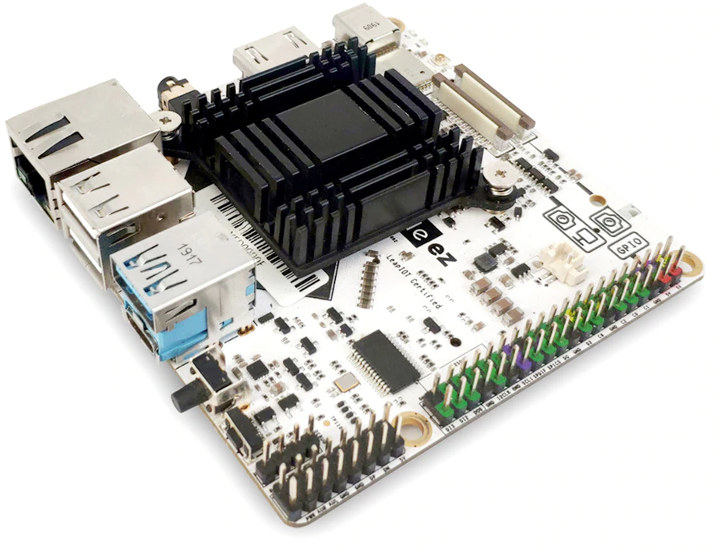It’s always interesting to look into mainline Linux changelog either to find out about new software features, but also new hardware platform. And earlier today, I wrote about Linux 5.4 release, I noticed comments about “Leez RK3399 P710 SBC“.
After searching a bit, it turns out it’s a single board computer by Lenovo, which the company apparently showcased at World Mobile Congress in Spain last February. Leez is apparently a team part of Lenovo.
 Lenovo Leez P710 board specifications:
Lenovo Leez P710 board specifications:
- SoC – Rockchip RK3399 hexa-core processor with 2x Cortex-A72 cores @ up to 2.0 GHz, 4x Cortex-A53 cores, and an Arm Mali-T860MP4 GPU
- System Memory – 2 or 4GB LPDDR4
- Storage – 16GB eMMC flash, MicroSD card slot
- Video Output – HDMI 2.0a up to 4K @ 60 Hz, 4-lane MIPI DSI, DisplayPort via USB-C port
- Audio – Audio jack + digital audio output via HDMI
- Camera I/F -2x 4-Lane MIPI-CSI
- Connectivity – Gigabit Ethernet, 802.11b/g/n/ac WiFi + Bluetooth 5.0 via Ampak AP6256 SiP, optional 4G LTE connectivity
- USB – 1x USB 3.0 port, 2x USB 2.0 port, 1x USB 3.0 Type-C port (separate from USB-C port for power)
- Expansion
- 40-pin GPIO header with 2x 3V/1.8V I2C, 1x 3V UART, 1x 3V SPI, SPDIF_TX, up to 8x 3V GPIOs, 1x 1.8V 8-channels I2S
- 8-pin header with 2x USB 2.0 host, LED, PWR, Reset, audio output
- M.2 B-key socket for 4G LTE card + SIM card slot
- Debug – 4-pin UART header
- Misc- Power key, power LED, user RGB LED
- Power Supply – 5V/3A via USB Type-C port
- Dimensions – 85×85 mm

 There’s very little info on Lenovo website, which also lists another board – Leez P515 – powered by a Texas Instruments Sitara processor. But we get many more details on Github at least for Leez P710 board. That’s where I got more detailed specifications, and we can find the firmware files and tools for the SBC such as Android 7.1 & 9.0, as well as Debian. Schematics and other resources are also available on that page.
There’s very little info on Lenovo website, which also lists another board – Leez P515 – powered by a Texas Instruments Sitara processor. But we get many more details on Github at least for Leez P710 board. That’s where I got more detailed specifications, and we can find the firmware files and tools for the SBC such as Android 7.1 & 9.0, as well as Debian. Schematics and other resources are also available on that page.
The board may target the Chinese market, but I could also notice it for sale on Aliexpress for about $140 shipped, including heatsink and WiFi antenna. You’ll also find bundles with various accessories including a debug board, camera module, 4G module, or 10.1″ touch screen display.


Jean-Luc started CNX Software in 2010 as a part-time endeavor, before quitting his job as a software engineering manager, and starting to write daily news, and reviews full time later in 2011.
Support CNX Software! Donate via cryptocurrencies, become a Patron on Patreon, or purchase goods on Amazon or Aliexpress





CPU is in the wrong side of the pcb!
I don’t know much about SBC but where should it be?
On the bottom side with the memory where they can both be easily heatsunk to a metal case to proved first rate cooling.
This PCB is large enough to hold a proper heat sink. I see nothing wrong, other than being “yet another RK3399″™
They’ve provided mounting posts for what looks like a standard sized PC heat sink. If you think you need extra cooling or want to couple the heat sink to a metal case you should be able to do that.
A nice surprise. Looks ok, but bit pricey. The more RK3399’s on the market the better. At least if they sell.
Can only help the development for Linux.
I’m using the M4V2 as main desktop. The SoC is capable enough. And I/O is top of the market.
I do wish to see something more powerful, but with the same expandability as the RK3399’s.
The VIM3 really suffers from only having one USB3. And the N2 its USB3 is even worse.
One day we’ll have it all in one board. Then I can stop reviewing them.
Cheers.
>Can only help the development for Linux.
Someone like Google using millions of them in something and demanding that rockchip mainline everything would help. A few thousand maker boards not so much.
“Someone like Google using millions of them in something”
In fact Google has produced its own development board called “Coral” using NXP’s iMX8M system-on-chip.
Google has just ( reported on Softpedia on November 25, 2019) released Mendel 4.0 (based on Debian 10) which is being developed specifically for the “Coral” board.
>In fact Google has produced its own development board called “Coral” using NXP’s iMX8M system-on-chip.
They probably did precisely because Freescale/NXP actually works to mainline their stuff. AFAIK Amazon are still shipping stuff with crappy mediatek SoCs and 3.18 kernels.
I have both the NanoPi m4 2GB ($50) and the Ras Pi 4 4gb ($55). For Ham radio it is a No Brain-er the Ras Pi 4 is, I think not only faster (2.14 overclock) but the software just works. As a general computer the Pi4 and its new desktop software again works straight out of the box. The M4 RK3399 was the bleeding edge chip when I bought it but the software development has not occurred / kept up and it is often painful thing to use and set up. For my future projects I will be standardizing on… Read more »
Wake me up when someone invents a multicore that wont melt to China like a nuclear reactor just because you load it. Multicore embedded systems are worthless imho. Two cores is pretty much the limit.
Not the best layout unfortunately. By increasing the board size compared to other vendors, they had plenty of room to move all the connectors on the same side which would have allowed to design small terminals and small PCs. But no, they reproduced the raspi error consisting in placing HDMI+power on one side and ethernet+usb on another one, making it impossible to include it in a box in a way that’s convenient for a user. If they absolutely need to have two sides, they can have USB+audio+power button on one side and the permanent cables (HDMI+RJ45+power+other USB) on another side.… Read more »
The ports are probably in those positions to get the traces from the SoC to the ports without having to make a huge detour all over the board that would make laying out the rest of it harder.
IMHO it looks fine. You have your fixed monitor, power and audio on the back and your usb for input on the side. If you fixed this to the back of a monitor you’d have access to the input connectors without trying to get your hand in under it etc.
If you place it behind the monitor it can work. But when you see a jack, it’s more suited to a light terminal to place vertically on the desk so that you have access to the jack and USB to connect headphones and thumbdrives. In this case you have the HDMI or RJ45 facing you, not very convenient.
If I bought one of these it would be hanging in the air from a cable plugged into the ethernet jack with junk hanging off of the 2.54mm headers. I think that’s the general use case here. If people wanted a slow desktop with poor GPU driver support they have better options.
What you’re saying would need a standard form factor, and this is not one, so any such uses of the board would require custom casing anyway.
>What you’re saying would need a standard form factor,
The board size is pretty close to pico itx (+2cm/-1cm) so I think they would have gone for that if this was meant to be put in a box.
Not necessarily, the form factor is always a way to offer possibilities. This board is already way larger than a regular whatever-Pi board for no extra features. Yes in fact there is: they added a power button. It’s a bit larger (and expensive) for just an extra button.
> This board is already way larger than a regular whatever-Pi board for no extra features SIM card slot and M.2 socket for a modem (according to Aliexpress also carrying PCIe signals). But why bother? Nobody interested in an RK3399 SBC will buy this device at this price anyway so it either has a different target audience or won’t sell. The vendor’s ‘Linux support’ clearly indicates different target audience since all they do is basing on 4 years old Rockchip stuff. Their kernel is based on https://github.com/sausiliu-lee/kernel with 4 DT related patches on top, so they’re just ‘5888 commits behind… Read more »
Just had a look at the board’s mainline arrival in 5.4: https://github.com/torvalds/linux/blob/master/arch/arm64/boot/dts/rockchip/rk3399-leez-p710.dts#L147-L148 vs. https://github.com/leez-SBC/kernel/commit/c879f1cc52a4fcb6aa1ce8f068a678d705cabbbb
So the mainline DT contribution is most probably just adopted copy&paste from another board while Ethernet is only supposed to work with the adjusted delay values contained in the board maker’s fork of the SoC vendor’s kernel fork from few years ago.
Linux on ARM business as usual…
>Linux on ARM business as usual…
Even if you have to run an old kernel and live in fear of a dist upgrade breaking everything surely it’s worth it to know that you’re only running 100% organic 8-bit legacy free instructions.
How much spyware is embedded in the bios? Asking for a friend.
We recently scrapped an RK3399 project mid design and moved to AMlogic S922X as everything was superior, including the price. Odroid seems to have done a similar thing. At this moment in time Rockchip seem to be caught mid cycle and only next year will they catch up. My guess is this product isn’t competitive.
I’ve just been informed the board will be available on Seeed Studio next week.
Now on Aliexpress
https://www.aliexpress.com/item/1005001515882659.html?
The link in the article (also Aliexpress) is a bit cheaper. They seem to have a promotion for Black Friday too.